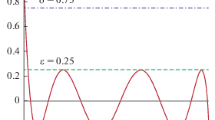Abstract
A special feature of the p-version of the finite element method for solving a differential boundary value problem stated in the form of minimizing a quadratic functional on a certain set is studied. This special feature results in approximate solutions remaining unchanged on finite numbers of increasing finite-dimensional subsets of increasing dimension, in which solutions are sought. Necessary and sufficient conditions for the existence of this feature are found, and the stagnation effect is interpreted for a specially constructed example. For the adaptive p-version of the finite element approach, a modified strategy is proposed that takes this feature into account and thus improves the reliability of the method.
Similar content being viewed by others
References
I. Babuska and W. C. Rheinboldt, “A posteriory error estimates for the finite element method,” Int. J. Numer. Methods Eng. 12, 1597–1615 (1978).
I. Babuska and W. C. Rheinboldt, “Error estimates for adaptive finite element computations,” SIAM (Soc. Ind. Appl. Math.) J. Numer. Anal. 15, 736–754 (1978).
R. E. Bank and A. Weiser, “Some a posteriory error estimates for elliptic partial differential equations,” Math. Comput. 44, 283–301 (1985).
M. Ainsworth and J. T. Oden, “A procedure for a posteriory error estimation for h-p-finite element methods,” Comput. Methods Appl. Mech. Eng. 101, 73–96 (1992).
M. Ainsworth and J. T. Oden, “A unified approach to a posteriory error estimation using element residual methods,” Numer. Math. 65, 23–50 (1993).
F. A. Bornemann, B. Erdmann, and R. Kornhuber, “A posteriory error estimates for elliptic problem in two and three space dimensions,” SIAM J. Numer. Anal. 33, 1188–1204 (1996).
R. Verfurth, “A posteriori error estimation and adaptive mesh-refinement techniques,” J. Comput. Appl. Math. 50, 67–83 (1996).
M. Ainsworth and J. T. Oden, “A posteriory error estimation in finite element analysis,” Comput. Meth. Appl. Mech. Eng. 142, 1–88 (1997).
O. C. Zienkiewicz, D. W. Kelly, J. P. de Gago, and I. Babuska, “Hierarchical finite element approaches, adaptive refinement and error estimates,” in The Mathematics of Finite Elements and Applications (Academic Press, London, 1982), pp. 313–346.
O. C. Zienkiewicz and A. Craig, “Adaptive refinement, error estimates, multigrid solution, and hierarchical finite element method concepts,” in Accuracy Estimates and Adaptiuve Refinements in Finite Element Computations (Wiley, Chichester, 1986), pp. 25–59.
R. E. Bank and R. K. Smith, “A posteriory error estimates based on hierarchical bases,” SIAM J. Numer. Anal. 30, 921–935 (1993).
E. S. Nikolaev, “Adaptive mesh refinement in boundary value problems for linear ODE systems,” Vestn. Mosk. Univ., Ser. 15: Vychisl. Mat. Kibern., No. 3, 11–19 (2000).
Nikolaev E.S. “Method of solving a boundary value problem for a second order ODE on a sequence of adaptively refined and coarsened meshes,” Vestn. Mosk. Univ., Ser. 15: Vychisl. Mat. Kibern., No. 4, 5–16 (2004).
E. S. Nikolaev and O. V. Shishkina, “A method of solving the Dirichlet problem for the second-order elliptic equation in a polygonal domain on an adaptively refined mesh sequence,” Vestn. Mosk. Univ., Ser. 15: Vychisl. Mat. Kibern., No. 4, 3–15 (2005).
N. D. Zolotareva, and E. S. Nikolaev, “Method for constructing meshes adapting to the solution of boundary value problems for ordinary differential equations of the second and fourth orders,” Differ. Equations 45, 1189–1202 (2009).
N. D. Zolotareva, and E. S. Nikolaev, “Adaptive P-version of the finite element method for solving boundary value problems for ordinary second-order differential equations,” Differ. Equations 49, 835–848 (2013).
A. A. Samarskii, The Theory of Difference Schemes (Nauka, Moscow, 1989; CRC Press, New York, 2001).
Author information
Authors and Affiliations
Corresponding author
Additional information
Original Russian Text © N.D. Zolotareva, E.S. Nikolaev, 2014, published in Vestnik Moskovskogo Universiteta. Vychislitel’naya Matematika i Kibernetika, 2014, No. 3, pp. 5–13.
About this article
Cite this article
Zolotareva, N.D., Nikolaev, E.S. Stagnation in the p-version of the finite element method. MoscowUniv.Comput.Math.Cybern. 38, 91–99 (2014). https://doi.org/10.3103/S0278641914030108
Received:
Published:
Issue Date:
DOI: https://doi.org/10.3103/S0278641914030108




